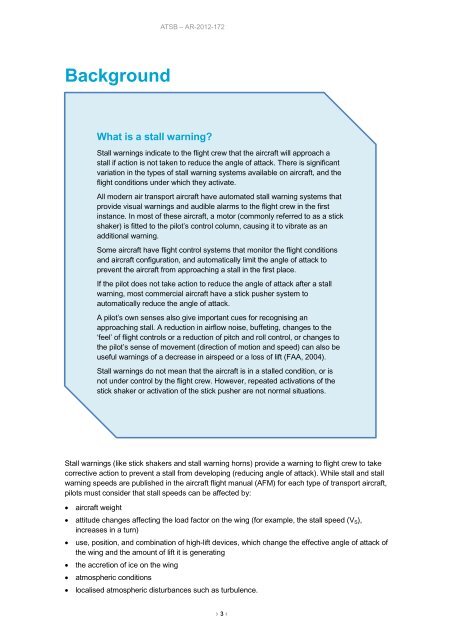Stall warnings in high capacity aircraft: The Australian context 2008 ...
Stall warnings in high capacity aircraft: The Australian context 2008 ...
Stall warnings in high capacity aircraft: The Australian context 2008 ...
Create successful ePaper yourself
Turn your PDF publications into a flip-book with our unique Google optimized e-Paper software.
ATSB – AR-2012-172<br />
Background<br />
What is a stall warn<strong>in</strong>g?<br />
<strong>Stall</strong> <strong>warn<strong>in</strong>gs</strong> <strong>in</strong>dicate to the flight crew that the <strong>aircraft</strong> will approach a<br />
stall if action is not taken to reduce the angle of attack. <strong>The</strong>re is significant<br />
variation <strong>in</strong> the types of stall warn<strong>in</strong>g systems available on <strong>aircraft</strong>, and the<br />
flight conditions under which they activate.<br />
All modern air transport <strong>aircraft</strong> have automated stall warn<strong>in</strong>g systems that<br />
provide visual <strong>warn<strong>in</strong>gs</strong> and audible alarms to the flight crew <strong>in</strong> the first<br />
<strong>in</strong>stance. In most of these <strong>aircraft</strong>, a motor (commonly referred to as a stick<br />
shaker) is fitted to the pilot’s control column, caus<strong>in</strong>g it to vibrate as an<br />
additional warn<strong>in</strong>g.<br />
Some <strong>aircraft</strong> have flight control systems that monitor the flight conditions<br />
and <strong>aircraft</strong> configuration, and automatically limit the angle of attack to<br />
prevent the <strong>aircraft</strong> from approach<strong>in</strong>g a stall <strong>in</strong> the first place.<br />
If the pilot does not take action to reduce the angle of attack after a stall<br />
warn<strong>in</strong>g, most commercial <strong>aircraft</strong> have a stick pusher system to<br />
automatically reduce the angle of attack.<br />
A pilot’s own senses also give important cues for recognis<strong>in</strong>g an<br />
approach<strong>in</strong>g stall. A reduction <strong>in</strong> airflow noise, buffet<strong>in</strong>g, changes to the<br />
‘feel’ of flight controls or a reduction of pitch and roll control, or changes to<br />
the pilot’s sense of movement (direction of motion and speed) can also be<br />
useful <strong>warn<strong>in</strong>gs</strong> of a decrease <strong>in</strong> airspeed or a loss of lift (FAA, 2004).<br />
<strong>Stall</strong> <strong>warn<strong>in</strong>gs</strong> do not mean that the <strong>aircraft</strong> is <strong>in</strong> a stalled condition, or is<br />
not under control by the flight crew. However, repeated activations of the<br />
stick shaker or activation of the stick pusher are not normal situations.<br />
<strong>Stall</strong> <strong>warn<strong>in</strong>gs</strong> (like stick shakers and stall warn<strong>in</strong>g horns) provide a warn<strong>in</strong>g to flight crew to take<br />
corrective action to prevent a stall from develop<strong>in</strong>g (reduc<strong>in</strong>g angle of attack). While stall and stall<br />
warn<strong>in</strong>g speeds are published <strong>in</strong> the <strong>aircraft</strong> flight manual (AFM) for each type of transport <strong>aircraft</strong>,<br />
pilots must consider that stall speeds can be affected by:<br />
• <strong>aircraft</strong> weight<br />
• attitude changes affect<strong>in</strong>g the load factor on the w<strong>in</strong>g (for example, the stall speed (V S ),<br />
<strong>in</strong>creases <strong>in</strong> a turn)<br />
• use, position, and comb<strong>in</strong>ation of <strong>high</strong>-lift devices, which change the effective angle of attack of<br />
the w<strong>in</strong>g and the amount of lift it is generat<strong>in</strong>g<br />
• the accretion of ice on the w<strong>in</strong>g<br />
• atmospheric conditions<br />
• localised atmospheric disturbances such as turbulence.<br />
› 3 ‹
















